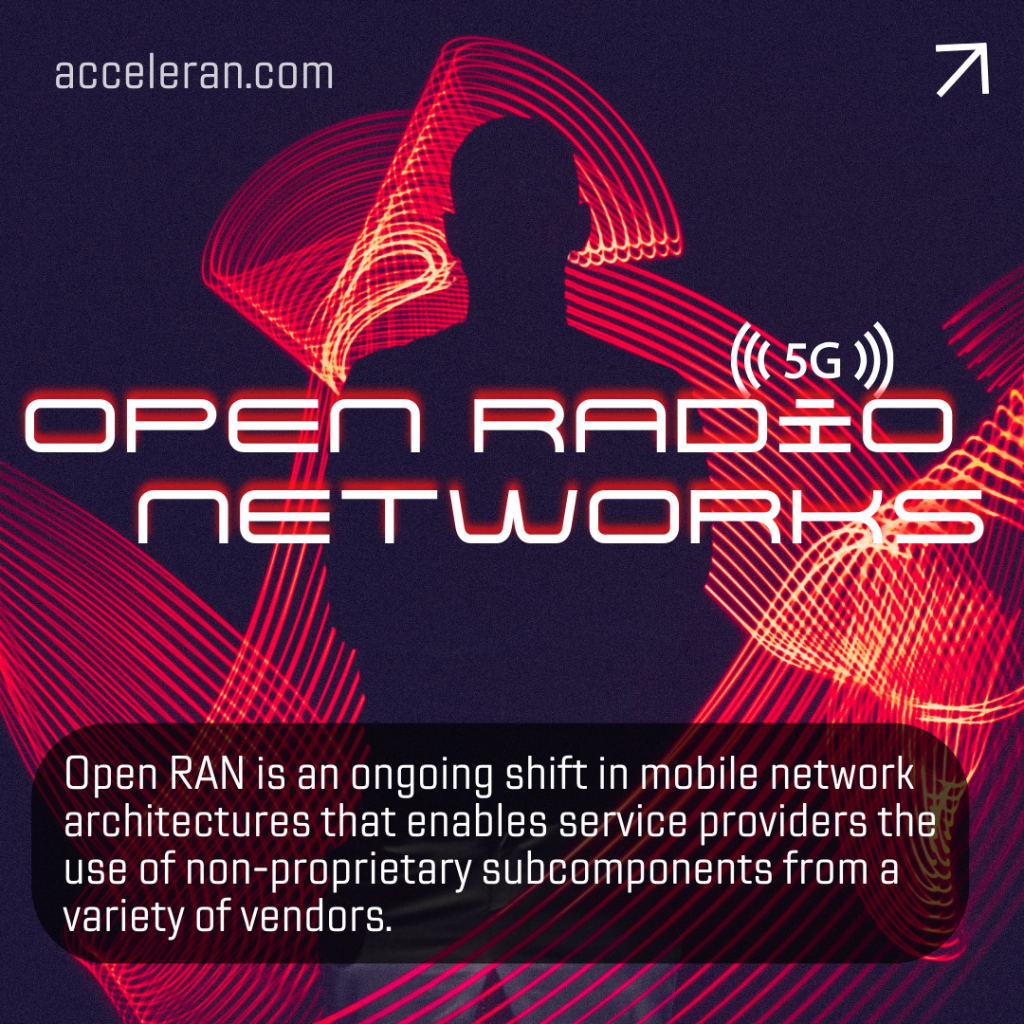
Powering Offshore Wind with Private 5G: Smarter, Safer, and More Resilient Operations
Offshore wind needs smarter operations. Explore how Private 5G enables real-time monitoring, predictive maintenance, and safer crews
The Accelleran Academy is your go-to source for the latest updates on 5G use cases, RAN Intelligence, and more.
Follow Accelleran for Real-Time Updates.

Too often, diving into the realm of Open RAN feels like plunging into a pool of technical jargon.
We understand the need for clarity without complexity. So, we’re taking a different approach.
Welcome to your simplified guide to Open RAN,
In essence, Open RAN is about breaking up traditional mobile networks into their individual components and making them ‘open’. This means allowing various vendors to provide parts of the system, promoting innovation and reducing costs.
Telecommunications is an industry that is constantly evolving – but Open RAN in particular stands out as a beacon for change. But what vision drives this change, and why is it resonating with industry leaders and innovators alike?
The primary vision behind Open RAN is to redefine the fundamentals of mobile networks. Traditionally, operators were bound to a single vendor, purchasing integrated systems that often lacked flexibility and adaptability. Open RAN revolutionises this approach by ‘opening up’ the radio access networks, allowing for greater interoperability and diversification.
Consider the inner workings of a laptop: you might find an Intel processor, a Samsung hard drive, and an Nvidia graphics card. This mix of competitive components has substantially driven down laptop prices over the years due to innovation spurred by competition. Now, imagine if a single vendor supplied every component of that laptop. While sourcing replacements might be straightforward, there’d be limited motivation for that one vendor to enhance processing speeds, improve display quality, or reduce costs. It’s a scenario few would tolerate.
So what does Open RAN aim to do to the telecom industry?
Flexibility & Innovation: By decoupling hardware from software, operators can mix and match components from different vendors. This not only fosters competition but also encourages technological advancements. An open environment breeds innovation, as multiple players contribute their unique solutions to enhance the ecosystem.
Cost Efficiency: Traditional network setups required hefty investments, with operators tied down to proprietary systems. Open RAN promises reduced capital and operational expenses. By breaking away from the one-size-fits-all model, operators can now select components based on both performance and cost-effectiveness.
Adaptability & Future-Proofing: As the demand for data grows and user requirements change, networks must evolve. Open RAN ensures that networks remain adaptable, ready to incorporate future technologies without extensive overhauls. The modular nature of Open RAN means that upgrades or replacements can be done component-wise, paving the way for a more sustainable and scalable network infrastructure.
In essence, the vision of Open RAN is to create a dynamic, collaborative, and competitive landscape in telecommunications. It’s about preparing for the future, ensuring that networks are robust, agile, and innovative. With Open RAN leading the charge, the telecommunications industry is poised to experience a paradigm shift, where collaboration and openness become the cornerstones of progress.
Governments worldwide are also casting their vote of confidence in Open RAN. Their backing often stems from a desire to diversify their telecommunication supply chains, reduce reliance on singular vendors, and boost national security. By fostering a diverse vendor ecosystem, Open RAN reduces the risks associated with dependency on a single provider, which can be vulnerable to geopolitical tensions or supply chain disruptions.
The diagrams below demonstrate a simplified view of a traditional network setup versus one that is Open RAN aligned.

By opening up the network, Open RAN paves the way for a more flexible, efficient, and cost-effective communication infrastructure. Instead of one vendor locking down the entire system, different experts can bring their best to the table.
Open RAN is reshaping the way we think about mobile networks, ensuring a future where connectivity is more adaptable, innovative, and inclusive. Now, the next time someone asks, “What is Open RAN?” you’ve got a straightforward answer.
Open RAN is an approach to mobile networks that breaks down traditional network components and makes them ‘open.’ This means different vendors can provide parts of the system, leading to greater flexibility, innovation, and cost savings.
By decoupling hardware from software, Open RAN allows operators to mix and match components from different vendors. This fosters competition and encourages technological advancements, as multiple players contribute their unique solutions to improve the network.
Open RAN can reduce both capital and operational expenses by allowing operators to select components based on performance and cost-effectiveness, rather than being tied to a single vendor’s proprietary system.
Open RAN supports a modular network structure, making it easier to upgrade or replace components individually. This adaptability ensures that networks can evolve with changing demands and incorporate future technologies without needing extensive overhauls.
Governments support Open RAN to diversify their telecommunications supply chains, reduce reliance on single vendors, and enhance national security. A diverse vendor ecosystem reduces the risks associated with dependency on one provider, particularly in the face of geopolitical tensions or supply chain disruptions.

Offshore wind needs smarter operations. Explore how Private 5G enables real-time monitoring, predictive maintenance, and safer crews

The event brought together leading voices from across the global telecoms ecosystem to explore the state of the Open RAN market and showcase ongoing innovations

MWC Barcelona 2025 was a successful event for Accelleran, with more of our colleagues attending than ever before. Over the course of the week, we